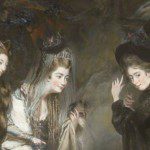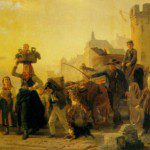I’m working on a book about grimoires, magical tomes, and BoS’s (Book of Shadows). Yesterday I finished up most of my research on The Necronomicon and left a note on my Facebook page sharing my glee about being through with it. That resulted in comments like “you know it’s fake, right?”
But is it fake? There are about a million paperback copies out there of a book called The Necronomicon written allegedly by a guy named “Simon.” Those books certainly aren’t fake; they have pages, glue, crudely drawn symbols, and rituals. So why do some of my friends think that it’s a fake?
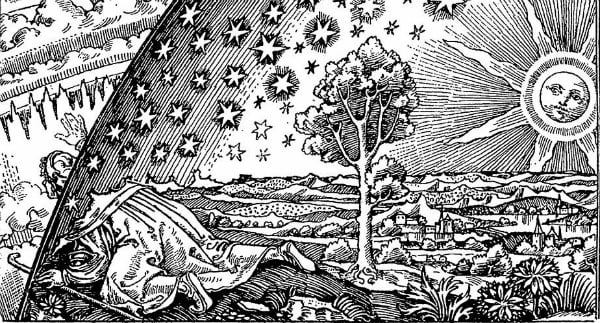
In many ways Simon’s Necronomicon is both real and a hoax. Let me back up here for a second. For those of you unfamiliar with The Necronomicon it began its life as a fictional book in the short stories of horror writer HP Lovecraft. It turned out to be such a popular device that other writers picked up on it as well.
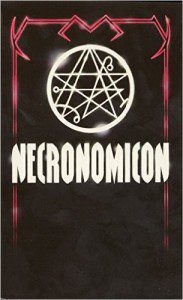 The Necronomicon in no way predated Lovecraft, nor did Lovecraft ever create a “version” of the book to use as a resource while writing his stories. He did create a backstory for his imaginary book, but that’s the kind of thing good writers do. So while no real version directly related to Lovecraft exists that hasn’t stopped people from wanting there to be one, and eventually a few folks figured out that there was money to be made in The Necronomicon business.
The Necronomicon in no way predated Lovecraft, nor did Lovecraft ever create a “version” of the book to use as a resource while writing his stories. He did create a backstory for his imaginary book, but that’s the kind of thing good writers do. So while no real version directly related to Lovecraft exists that hasn’t stopped people from wanting there to be one, and eventually a few folks figured out that there was money to be made in The Necronomicon business.
In the 1970’s versions of The Necronomicon began to appear in occult bookstores. The most famous of these is the Simon version, first issued in the late 70’s by Magickal Childe and then in 1980 by Avon Publishing. The Avon version has been continuously in print since it was first released and is probably the cheapest and most easily available “grimoire” on the planet. “Simon” might be the most successful occult author of all time (at least from a financial perspective). Simon’s book has an elaborate bullshit backstory, and while it claims to be a text from the Ninth Century there’s no evidence to back up that claim. If a ninth century manuscript appeared in the 1970’s written by someone calling themself “The Mad Arab” I think it’s first translation would be in a scholarly journal, and not a cheap paperback book.
I’m not going to go into a complete history of The Simonomicon, but suffice to say its backstory and ties to Ancient Sumer are complete nonsense. The Simon Necronomicon is a product of the 1970’s, but borrows extensively from Sumerian and Mesopotamian myth, Lovecraft, Crowley, and Western Ceremonial Magic. One of the problems with the mishmash of information in the Simonicon is that much of it is real magical material. However there’s very little context for it, especially a problem for the uninformed whose first exposure to magic is the Simonicon. Simon’s book is clearly an elaborate hoax, but it’s a hoax with power.
In The Necronomicon Files author John Wisdom Gonce III shares a post from a member of the alt.magick.newsgroup who had a frightening experience with Simon’s book:
“I will elaborate, the vibrations, which haunted me had also the effects that it felt as if parts of my soul and body were dead. (This is difficult to explain.) At times I was afraid that some evil parts of myself, which seemed to thrive on the emanating vibrations would become powerful enough to possess me. It was somethings like being trapped in one of Baudelaire’s poems. But colder.” pg. 164
This is why The Necronomicon is both real and a hoax. The nonsense surrounding its age and history are bogus, but it’s real in that its rituals sometimes contain actual power and bring about certain results.
Simon’s book is not the first grimoire with a dubious backstory. In fact the history of magical books is full of fictions. One of the occult’s most enduring grimoires is the Clavicula Salomonis, better known as The Key of Solomon. Written in the fifteenth century there’s nothing actually linking tKoS to the legendary King Solomon. And while some have claimed that the book was originally written in Hebrew (as a way of linking it to Solomon) it was composed in Greek and then later translated into Latin and Italian before showing up in German, Spanish, and English. (1) Solomon’s Key is neither Jewish or written by Solomon, yet I hear very few people calling it a fake.
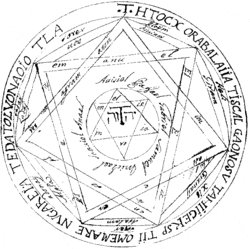
Authenticity goes far beyond the authorship of books. When I first got involved in Witchcraft I thought it was literally the “Old Religion” and that it dated back to at least the Middle Ages, if not the pre-agricultural era. I believe something entirely different now, but my faith in the working practices of Witchcraft hasn’t changed. If Modern Witchcraft was only fifty* or even twenty years old I wouldn’t be bothered by the revelation. More so than authenticity, it’s the results that matter. I care deeply about history and believe that knowing the historical context(s) behind our practices and holidays is enlightening. However I’m not going to abandon an idea like Maiden-Mother-Crone simply because it’s a relatively modern invention.
More About the Necronomicon and HP Lovecraft
For those who want to learn more about Lovecraft and his fictitious book the best place to start is most certainly in The Necronomicon Files: The Truth Behind the Legend by Daniel Harms and John Wisdom Gonce III. It’s an extensive look at just about everything ever written or said about The Necronomicon, and as a history of books with the title Necronomicon it’s damn near masterful. However the best parts of the book are a complete debunking of the Simonicon, which clearly reveal that the Mad Arab’s grimoire is not an ancient piece of magical literature. Gonce’s style is a bit combative, but it’s also fun. The only downside to the book is that it was released ten years ago. On the plus side, Daniel Harms’s website does a great job of keeping the work up to date, and reveals the true identity of Simon.
Also useful to me was John L. Steadman’s HP Lovecraft & The Black Magical Tradition, which was just released last week. The first third of the book is great for people looking for an introduction to Lovecraft. There’s a nice examination of Lovecraft’s influences and a bit on what he knew (and really didn’t know) about the occult. I’ve never been a huge Lovecraft fan so reading the histories of Lovecraft’s deities was also enlightening. This part of the book was engaging and an easy read, a bit more so than the Necronomicon Files. The last half of the book goes off the rails a little bit by insisting that Simon’s Necronomicon might be the real deal. I would have appreciated more skepticism. The last third of the book is about Lovecraft’s influence on Modern Witchcraft, Voodoo traditions, and the Church of Satan. It doesn’t really fit with the rest of the book’s material and I was disappointed with some of Steadman’s history on those traditions. Despite my reservations about certain parts of the book, the parts I enjoyed are worth a second look the next time I might have to visit Lovecraft and his Necronomicon.
To some degree our imaginations power magical practice. A good magician or Witch has to be able to focus on what they want and visibly see what it is they wish to manifest. Sometimes I think linking a tradition to a mythic past, no matter how recent that tradition might be, gives the magic a little extra energy. People seem to like elaborate histories and connections to famous figures. The Key of Solomon doesn’t contain any wisdom from Solomon (if he even existed) but he was a fellow user of magic. Invoking his name connects me to that current in a way that a dubious history never will.
So does authenticity matter? I think things have more power when they are attached to truth, which is one of the reasons I spend so much time reading and writing about history. However belief in a mythic past powers the magic of many magicians. In the end it’s more about what works and doesn’t work. I also don’t have an easy yes or no answer. Gerald Gardner once said that “witches are consummate leg-pullers; they are taught it as part of their stock and trade,” and apparently so are grimoire writers.
Notes
1. From “Grimoires: A History of Magic Books” by Owen Davies, Oxford University Press, 2009. That bit came form page 15.
*I tend to use the 1939 as the starting date of the Modern Craft because that’s the year Gerald Gardner was initiated in New Forest. I’m relatively sure that other people were practicing forms of what today would call Witchcraft even earlier than that.


